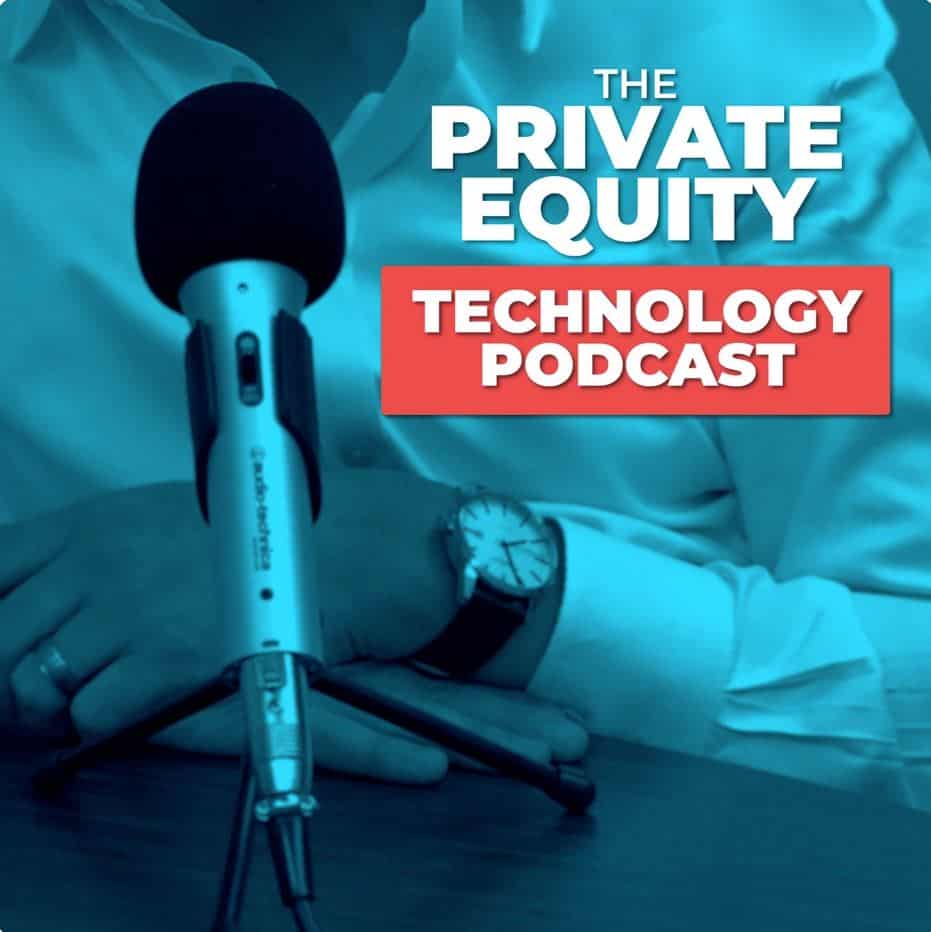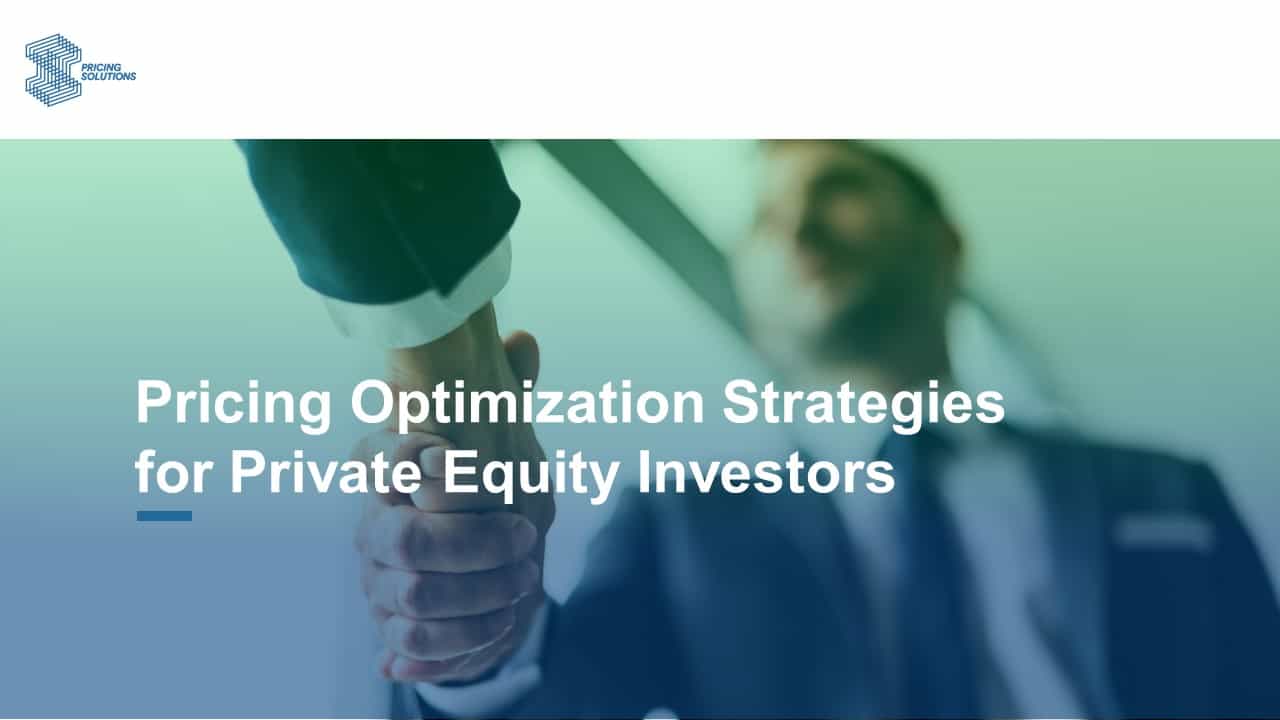Private Equity Technology Podcast
Episode 32 – The Importance Of Pricing
Despite evidence that pricing is the most critical predictor of profitability, the science of pricing is still relatively underdeveloped for most portfolio companies, and few have optimized their pricing to maximize profits. Pricing is therefore often one of the first levers Private Equity firms should be looking to look to optimize – gaining control over pricing strategy, processes and establishing the foundation for value-based pricing.

Listen to Pricing for Private Equity Podcast
About PE Technology Podcast
![]() The Private Equity Technology Podcast explores the inner workings of the technology applications and people running your potential acquisitions or portfolio companies, providing you another lever to pull as you look to maximize returns.
The Private Equity Technology Podcast explores the inner workings of the technology applications and people running your potential acquisitions or portfolio companies, providing you another lever to pull as you look to maximize returns.
About Paul Hunt

As President of Pricing Solutions, Paul have specialized in pricing for over 20 years over 1,000+ client engagements in a wide range of industries. He has developed, written and spoken on proprietary pricing methodologies including the 5 Levels of World Class Pricing and New Product Price Optimization.
Other Pricing for Private Equity Resources
Pricing for Private Equity Podcast – Transcript
[00:00:10] Hey welcome back to the Private Equity Technology Podcast. I’m Alex Agran. Here again with my co-host Lisa Weaver-Lambert. Today we’re speaking with Paul Hunt, Global President of Pricing Solutions. Pricing imperative in the products that you sell. There’s a big technology element to it as well. That’s why Paul is here to chat with us. Paul, really appreciate you coming on the podcast!
[00:00:36] Great. It’s a pleasure to be here. Thank you so much for the invite.
[00:00:40] As we do with our guests, if you would a little bit about you and Pricing Solutions and then we’ll get into the details…
[00:00:49] Sure. Thanks Alex. So, Pricing Solutions is a boutique consultancy specializing in exactly what our name says – pricing. And we’ve been in business for twenty-five years and we help companies grow profitability and market share through improved pricing. So that’s it in a nutshell.
[00:01:08] So Paul we’d love to get your perspective on why pricing is so important for private equity investments and your experience around working with portfolio companies
[00:01:25] If the average company improves the top line by 2 percent and is actually able to hold onto it. So, if they’re able to take price capture price through their increasing prices or reducing discounts or cost to serve which we consider part of price, then the impact for the average business on the bottom line is 25 percent. So, improve the top line by 2 percent and grow the bottom line by 25 percent. It’s the single highest leverage item a company has for driving profitability improvement.
That’s particularly of interest to private equity businesses because they’re selling most of the businesses they acquire. So, as they turn them around and prepare them for sale, what the private equity company gets is a multiple on the bottom line. So, if we drive up that bottom line by 25 percent, private equity is often getting a multiple of 10 to 20 times on that. So, the leverage is significant and dramatic. And so, you know, you asked about our work with private equity companies… Most of the work we do is with portfolio companies of private equity businesses that are looking to deploy that math. We’ve helped many companies many portfolio companies go through that process and help them dramatically improve profitability and hence grow the sale price.
[00:02:53] How do you get into the topic of pricing with them? How do you get it surfaced as a key lever to move forward and does it come in different levels within a company in terms of sophistication?
[00:03:08] A lot of private equity companies have put an emphasis on pricing. We’ve been approached by many private equity companies over the years. There’s still quite a number though that aren’t giving sufficient emphasis to pricing. They’re focused on other aspects of turning around growing and making businesses more profitable. We think pricing is an untapped lever, a huge untapped lever that all private equity companies should be tapping into. And there’s absolutely different levels of sophistication, Lisa. So, the way we view is there’s really five levels of pricing maturity. We call it the five levels of World Class Pricing. Level one is Firefighting, very ad hoc pricing, very out of control, sales force is calling the shots… Kind of putting the gun to the head of senior management and saying you know we’ve got to price this way or we’re not going to win the deal we’re going to lose the deal. And that’s really a tremendous opportunity for private equity businesses. So, as we go from Level 1 to 2, we call it the Policeman. It’s really about taking control of your pricing applying rules tools processes and guidelines and it’s very much target-margin-driven and a cost-plus environment. It’s not optimal, but it’s much better than a Level 1 ad hoc pricing. Often, finance is driving the rules tools and guidelines at Level 2. As a company proceeds beyond that and goes to what we call Level 3. We call that the Partner and that’s value-based pricing. It’s outside in, it’s based on deep customer understanding, segmentation is a core competency of businesses at level 3 and the improvements in profitability are once again dramatic. So going up each Level, 1 to 2, 2 to 3, there are significant and dramatic improvements in profitability often in the order of achieving that 2 percent that I spoke of. Going beyond Level 3, we moved to Level 4, which we call the Scientist and that’s bringing a lot more analytics, research and testing… So much more rigorous analysis to pricing, that is particularly suited for businesses that are data-rich and so there are some industries that are very well suited for that. Think the restaurant business, which has all sorts of POS data. Then, Level 5, we call the Master. It’s a company that has superior profitability. The CEO sees pricing as a strategic capability and the organization has a very senior and nimble pricing operation.
[00:06:01] What are the symptoms that you find when there is a pricing challenge, Paul?
[00:06:08] We see a lot of dispersion of pricing. So, when we start an engagement, we are always starting with analytics. We’re going to look at the business and really try and sort out what’s happening today. Often, what we’ll see is that pricing is all over the place. So, businesses, generally speaking, want similar customers buying similar products to pay similar prices. This meets the standard of fairness but also being pricing-based for value. What we see is that that’s not the case at all. That’s not being enacted by businesses. If you look at, analytically, the dispersion of prices, we see that they’re all over the place. And that’s because one of the things that happens with organizations is it’s not the best customers who get the best price, it’s the best negotiators. And so, companies have poor systems, they have poor infrastructure, they don’t have the rules tools, guidelines process and systems that are needed to support pricing policy and strategy that really drive business performance and meets the criteria of being value-based and fair.
[00:07:29] If we go back to your 5 Levels of pricing, what’s the technology at each level?
[00:07:40] So what we find is that the technology actually changes as you go up each level. I should say first, as you go up each level, there’s an infrastructure change at each level. So, there’s the systems that should be changing, the technology, the people that are running pricing, the processes, the structure of the reporting relationships, and the objectives of the organization – they all change. So typically, what we see with companies operating at Level 1, in a very ad hoc environment, it is really kind of a spread of Excel. There’s a lot of excel spreadsheets spread throughout the organization. They’re not well controlled. They’re constantly changed. There’s very poor control over them. There may be some prices that are built into the ERP but they’re always adjusted through Excel spreadsheets and things like that. So, that’s what we’re seeing at a Level 1 organization. When we move to Level 2, we talk about implementing rules and really having guidelines and a process. that is an excellent place for experiencing the full benefits of pricing automation. Level 2 is looking at automating controls and embedding pricing rules in a system, rather than relying solely on human judgment. And so, here using automation for control is necessary and valuable for the organization. When we move Level 3, we’re basically enhancing the technology that we’ve embedded in the organization. And now we’re going to build segmentation into the technology, so you want a system that’s robust enough to do that. We’re going to be creating more customized pricing, basically. As we move to Level 4, we’re getting to some very sophisticated automation at this point. Often, it’s dynamic pricing, algorithms that become a very dominant force at Level 4. And so, we need the technology that enables us to deploy those algorithms. So, these are some of the technology kind of changes and the characteristics of each of the levels, Lisa.
[00:10:22] How do you handle situations in which the portfolio companies leverage third-party software to run the day to day? It’s hard to get changes needed to put those checks and balances in place. This kind of gets loaded from an Excel spreadsheet, as you’re describing, but the ability to update them keep the checks and balances in place. It’s difficult to do without cooperation from that third party. Do you guys run into things like this? And if so, how do you help address those problems?
[00:11:05] I really don’t favor having third parties running our pricing for us, for an organization. I think that’s something that’s pretty mission-critical to keep control of for exactly the reasons that you’re describing, Alex.
So, if there’s any choice whatsoever, I would bring that internally within the organization. You know, the challenge with pricing is that because of the leverage I talked about, it’s so strategic to the business and it’s so important that you have to be able to control your pricing you cannot outsource it. When I talk about outsourcing, analytics you can outsource. We do analytics, for example, in the restaurant industry and we work for many private equity businesses that have restaurant investments. We do all the analytics that are fed into their system for establishing their menu prices. So outsourcing analytics is not a problem, but outsourcing your pricing infrastructure… That’s something that I would not be in favor of. It’s not an issue that we see with a lot of clients. So I’d need to know more about the specifics of your situation and the examples that you’re thinking of.
[00:12:22] Yes, if I could fine tune that just a little bit. There’s control for the pricing going into the system that ultimately handles the purchase, but there’s variability in the sales folks. The sales folks have the option to negotiate on prices from time to time and putting the checks and balances in place there becomes difficult. And you just alluded to the customers that know how to negotiate being able to get better pricing.
[00:13:00] And yeah you’re absolutely hitting on probably the biggest problem that B2B companies experience, Alex, which is there’s a lack of integration between the system and the sales force execution. And so that’s where we need LOA, levels of authority, for discounting, where sales salespeople simply have to have guidelines that they cannot go outside of without getting approval. Now sometimes the system approves it but that’s usually a pretty weak link because salespeople know how to game the system. So, there needs to be human intervention at that point that enables the organization to understand why or why we are discounting more, what’s different about this situation. And the real beauty of pricing automation of a good pricing system at Level 2 is that it often educates the sales force. So, what we have is one of the core methodologies of pricing as we get more advanced is something called micro segmentation. And what we’re doing is we’re looking at all the deals, all the transactions that happen. So, let me take a distributor, for example, a large distributor of hundreds of thousands of products and tens of thousands of customers. If you can use automation, you can use automation to very powerfully dig into. So, I’ve got a deal. It’s with an electrical contractor. It’s in in the residential market and it’s in Boston.
We can pull up all the deals that have happened that are of a similar size for similar customers in similar markets. And then we can look at what is the range of pricing and go back to the rep and say “look, the margin on the average transaction that you’re speaking of has been 50 percent. You’re looking for a 25 percent margin. What is unique about your deal versus these other similar customers buying similar products in similar markets?” And so now we can challenge the rep with data and if you don’t have a pricing automation system, you simply cannot do that. So that’s tremendous value in having availability of this information, so that you can actually start working with your sales force. But to your initial point, Alex, if you don’t have a check and balance where the rep has to ask for the discount, they just get to “hey I going to take 20 off here”. Then the system falls apart. You know there’s no value in the system. It’s not an acting policy or strategy.
[00:15:34] In your experience, Paul, who should be responsible and accountable for pricing in a company, because it seems to be a very interrelated discipline across functions?
[00:15:47] Yeah, that’s a great point, Lisa. Pricing is one of the most multi-functional aspects of a business. Every function has an opinion about pricing. Sales, most certainly, finance… So, sales typically say “we want prices to go down, we’re not competitive”, finance – “I want prices to go up! We need better margins, right.” Marketing is kind of somewhere in between – waffling sometimes up, sometimes down. So, there’s all sorts of opinions about pricing. And so, from a Pricing Solutions perspective, when we think of the 5 Levels of World Class Pricing, when we’re at Level 1, ad hoc, the first thing we need is control. So, as we move to Level 2, finance should be playing a significant role in pricing at Level 2. And sometimes, you know, that they control pricing. Ultimately that I mean you’ve got to get approval from finance to get discounts through and things like that.
[00:16:46] It’s very cost-plus, it’s not connected to the market, but it is significantly better than Level 1, where the sales force is enacting its own decisions. Then as we go to Level 3, value-based pricing, which, by the way, at Pricing Solutions our mission is to help clients get to at least Level 3. So, we don’t view Level 2 as sufficient, it’s a step on the journey. The Level 3, when you move to value-based pricing, then you’re looking at what reallyis connecting with the market, and finance is no longer the right function to be running pricing, because they don’t know what the market’s doing. So, at that stage we need marketing, but in many industrial businesses they’re not large enough. So, pricing is going to start being run by the C-Suite, somebody at a more senior level, who’s connected with the market. We could put it back into sales, but sometimes it is like putting Dracula in charge of the blood bank. It’s dangerous. The only thing that I’ve seen some private equity companies enact, is that they have a compensation structure for sales that is margin-driven, profit-driven. It moves away from volume and revenue and all those things that drive discounts.
And if you do that, then it’s not impossible for pricing to be controlled more by the sales department. But that’s a very big change from sales controlling it at Level 1. You know, there’s significant controls in place as you go further up. Many of our clients have a pricing department, they have a Vice President of Pricing, who has significant authority and that person often reports at the CEO level, so they’re reporting into the C-suite. For my most significant global clients, there’s a Vice President part of Pricing often reporting into the President or the Chairman of the business…
[00:18:45]…All the requisites that you have to have in place before you start working on pricing… For example, a clear customer segmentation.
[00:19:00] So that’s a big question – does segmentation come first or does pricing come first? I’m going to take a step back, first, my view is that any business could start a pricing initiative right away.
There’s nothing that needs to be in place for them to start looking at this subject deeply, if they feel that they’ve got a significant opportunity. My experience with the best PE companies is that the two core initiatives they have, when working on a new portfolio company, is that they work on the procurement side and they work on the pricing side. They just immediately have teams focused on change management of those two areas. So, you can always start analytics on pricing right away. It’s going to lead to bigger change management issues and ultimately to segmentation, as you get to Level 3, but you don’t need to have that in place before you get started. The analytics are going to uncover significant quick wins that can be enacted right away and an organization can take advantage of.
[00:20:14] And how to understand if you’ve got pricing power in a particular sector?
[00:20:20]So that’s the tricky part… A lot of executives know that today, they need to find out where their pricing power is. The challenge of most companies is they use cost- plus pricing, Lisa. Which has no connection to pricing power whatsoever it’s just a formulaic way of pricing. “I’ve got this cost, so I’m going to add this margin. Here’s my price.” And so, when they take price increases, they say “well I’m going to take, you know, 4-percent across the board.” Well that’s a useless way of change in price because some products don’t deserve 4 percent. They’re not competitive, so there’s no pricing power. And the moment that the sales team walks in and meets with procurement, they’re going to get beaten up by a well-informed procurement team that’s going to share data that shows that they’re priced out of the market and the sales force totally loses confidence. So, the way to find your pricing power is to do scoring. We score products, we score customers, we find ways of assessing pricing power. There’s different criteria that will help you determine if you’ve got more or less power. And we’ve written about that extensively and have various tools like the Pricing Power Assessment Tool, or micro-segmentation, or a variety of different methodologies that help you get there. but you need some way, some criteria and some way of classifying your products and your customers, so that you can sort out where is their pricing power and where isn’t there. So, for example a very simple criteria for assessing that would be “Last time we took a price increase, what happened if this product lose volume? Did we give it all back in discount or did we not experience any pushback whatsoever?”
Also, another criteria might be – is this a growing product or a shrinking product? If it’s shrinking, we’re probably not competitive, if it’s growing, we’re probably very competitive and we may be underpriced. So, if you use it, identify the criteria relevant to your business, score them, then you can figure out your pricing power and then you can go from there. Of course, there’s traditional elasticity as well. So, anything we can uncover with analytics is terrific. In the industries like restaurants or consumer-driven businesses, retail, the data really can help identify elasticity. When we get to B2B industrial commercial businesses, it’s much more trickier to uncover elasticity and the data is often misleading. So that’s where we get into scoring and things like that.
[00:23:09] When people talk about pricing automation what does that mean, Paul? And when should it be applied?
[00:23:17] So, for them when they’re talking about pricing automation, that’s how do we set prices. What’s the process is. Is technology helping us actually set prices? And then how do we actually determine prices that are going to come out of the system? And so, what’s the pricing coming out of the system. So, automation is playing a key role there as well. So, automation should be used in it within all organizations. You need good automation. There’s never a time where you don’t need effective automation. There’s way too much overreliance on excel.
[00:23:58] So the first thing we’ve got to do is, if we’re using Excel, we’ve got to get control of the Excel spreadsheets. We’ve got to bring back to Alex’s point some mechanism by which we have levels of authority and delegation and people have to get approvals for the prices that are coming out. As we get more sophisticated and we get beyond excel, we get into… And there’s a couple of different options: there’s pricing kind of ERP systems, there’s companies that sell pricing platforms, companies where you can put your products in, you put your prices in, you put your customers in and then it spits out prices, it has all sorts of reports, as I’ve mentioned dispersion analysis, things like that… That’s really valuable in our mind at Level 2 to get some kind of a pricing software suite. Or you can load that into ERP system, but you need something at that level as we go beyond that you’re just adding you know segmentation, you’re adding more complexity, and so you need something that’s more flexible and adaptive and it can meet your needs as you get to Level 4. You know we’re obviously getting to algorithmic-based pricing. That’s where, as I said, you might outsource your analytics and then pull your pricing into your ERP system. So you may not have a sophisticated pricing automation system at Level 4, because you’re outsourcing the analytics to somebody else and then just loading that into your system, but you still need a good system in order to be able to load the information and then make sure it’s distributed effectively throughout the organization. That’s critical.
[00:25:40] You’ve told quite a bit about data. What challenges have you had getting the right data from companies in order to even start the analysis?
[00:25:53] Yeah. That’s a really good question, Lisa. Because the number one challenge we run with clients is that they don’t have clean data. The data is very messy and that’s part of the challenge because of what I was talking about the Excel spreadsheets, right… The data is often dispersed in many different parts of the organization. Often, the first part of any work that we do with clients and that companies need to think about is just getting their data together and organized in a way that it actually provides insights. And so often that’s consolidating several different databases. And that’s the value of automation.
The value of having all the data in one place, so you’ve got one truth. And once you’ve got that, the 2-percent, 3-percent, 4-percent drops to the bottom line, because all of a sudden, you’ve got information by which to make better decisions. And something we haven’t really talked about, but, of course, is assuming all along here is that the company is building a smart strategy. You have to have a good pricing strategy, and if you don’t have a good pricing strategy, then you just automate a bad pricing strategy. We’re making bad decisions faster. So underpinning all this is a solid strategy. The importance of good data is critical. I just give you a situation – we have one client. They were a world-class company, you know, very well-managed and they’ve got a number of different divisions and they fully expect that they had great data, so they sent it to us. We worked with three different divisions. They were private equity owned. So, we started working with three different divisions and the two divisions’ data was very good and it was on their JD Edwards system. The third division had not yet gotten onto J.D. Edwards and their data was a mess, they were shocked. We had to go through about three rounds of cleansing and re-gathering and just kind of getting to a point where we actually had something we could utilize. Now, the good news is once we went through that painful process, they were able to dramatically improve profitability because of the lack of control was so bad. The ad hoc nature of pricing was so flagrant that they were really at the bottom of Level 1 and so they quickly grew profitability just through breathing and some good controls. So, you know, the worse things are in a way, the better the opportunity.
[00:28:37] So there’s a lot of data-analytics companies now. What guidance have you got for private equity firms? You know, who to partner with… Because your company is pricing specialists and some of them are quite generic.
[00:28:53] Yes. So, pricing is a pretty unique discipline. The thing is that the analytics are very helpful. But there’s a change management piece that goes with all this, because you’re trying to change behavior. You talked about the multi-functional involvement… You know how many people touch pricing. So, it’s not just one function… First of all, sales is deeply embedded in their beliefs and their experience about the market. So as much as the data might say “hey look at these problems, you know some customers are getting better prices than others that there shouldn’t be.” Well, the salespeople who sold that aren’t just going to believe the data. They know what they’re experiencing in the marketplace. So that’s where I come back to strategy.
We have to have a strategy that actually makes sense to people and we’re going to have policies that are going to be enforced that are based on the strategy that people have bought into. And so, those things you know are absolutely critical to making sure that you get buy in. So, there’s a soft side and a hard side to pricing. The hard side is analytics, facts, elasticity, economics, but there’s also a whole psychological component to pricing. There’s the mind and the heart and the heart side of it is you’re selling to people and people are paying prices. There are all sorts of perceptions. We’ve written extensively about the psychology of pricing and you know it’s funny how when you drop something from a dollar to ninety-nine cents sales go up 500 percent it’s not logical. It’s just the way it is in certain markets. So those kinds of things are, in our view, the value-add that we bring that go beyond just pure analytics. It’s how to make the whole package work. And I think that’s critical. For PE companies, often they’re coming in and make enacting quick changes and the analytics helps you get part of the way. But if you don’t have the hearts and minds of folks then you’re only going to realize half the benefits and you may alienate a lot of people along the way.
[00:31:58] So if we go back to your 5 Levels of pricing what is the timeline to improving price? If you’re sort of starting at Level 1, you said that you wouldn’t be satisfied until you got to Level 3. What kind of timeline does it take?
[00:32:15] So the good news is it is a very profitable journey. But it takes time… So, because of the change management piece I just talked about, Lisa… If we could just run the analytics and we had the automation, we get the data and we order people to just go execute the new policy, that would be great. We could get there fast – from 1 to 3, we’d be there and in the next six months. But the reality is that there’s the change management piece. You’re changing the culture of the organization; we’re moving from a heavy discounting environment to one where we’re selling the value and stuff like that.
So, going from Level 1 to 2, you can do that within 12 months, typically. Often you can have quick wins, where you’re achieving multiples of profitability improvement within the first six months. Just through enacting changes what we call quick wins and that comes out of analytics and things like that. So, you know within 12 months you can have significant improvement and kind of move from Level 1 to 2. To move from Level 2 to 3, you’re really looking at about another 12 months to go through that process. Realistically, if you want the sales force to really be onboard, if you really want to step change, in terms of improvement within the organization and then beyond that a similar amount of time to go to Levels 4 and 5.
[00:33:48] So, Paul, given the speed of change in data science that we’re experiencing right now, what is the impact on portfolio companies on the work that you do specifically with them?
[00:34:01] I can tell you I’m shocked at how many portfolio companies are reaching out to us or private equity companies saying “we know that we can’t run the analytics that we need to get done”. The companies don’t have the infrastructure, they don’t have the people. They may have some half decent analysts and data scientists and stuff. But when it gets into pricing, they just don’t have the expertise and they know they can’t go deep enough. I’d say it’s been exponentially changed in the last 12 months, where we’re hearing from companies that have that similar refrain. So, often the process we used to go through was pricing transformation projects. They were 16 to 20 weeks, four to five months. They involved sales force training, they involved a lot of change, a lot of redesigning of the pricing strategy, all those kinds of things… We still do those projects for clients that really have a commitment to wanting to change pricing longer term. But much more frequently, we’re getting engaged now with private equity companies that are saying “I need someone to come in and just do the analytics, so I can learn what’s going on in my business. And then I’ll move on to Part B.” And so, this is where we’re getting into… How do we measure elasticity? What is the cost to serve? What is the level of dispersion around discounting? How does the pricing waterfall look? Where are the opportunities within my organization? Everybody knows that analytics can help answer those questions, but very few companies know how to actually do the analytical work to get there. So that’s a really significant sea change I’ve seen, just the exponential change in the availability of data. Our team is now staffed by PhD and Master’s in data science and our analytics team has grown significantly over the last three or four years in response to this. And so it’s just a big wave that’s happening there.
[00:36:24] Paul, thank you for sharing all of these insights. Where can we find out more about you and Pricing Solutions? How can we get in touch with you?
[00:36:35] Yes. We’re located on the web, www.PricingSolutions.com, Lisa, and I can be reached out to personally at phunt@pricingsolutions.com. So, folks shouldn’t hesitate to reach out to me personally. If there’s interest or any questions coming out of this podcast, I’d be happy to answer them and engage in a conversation about those topics.
[00:37:09] Paul, really appreciate it! I thought that was excellent content. Thank you, Paul. Thank you very much.
[00:37:15] Thank you, Lisa. Thank you, Alex. It’s been a pleasure.
[00:37:18] Thanks for listening to the Private Equity Technology Podcast. Please support the production of this podcast by subscribing on iTunes and leaving a review if you want to reach out with any questions or comments you can get me at alexagrin@gmail.com.






